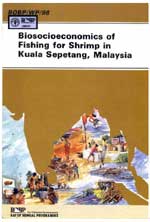All rights reserved. Reproduction and dissemination of
material in this information product for educational or other
non-commercial purposes are authorized without any prior written
permission from the copyright holders provided the source is
fully acknowledged. Reproduction of material in this information
product for resale or other commercial purposes is prohibited
without written permission of the copyright holders. Applications
for such permission should be addressed to the Chief, Publishing
and Multimedia Service, Information Division, FAO, Viale delle
Terme di Caracalla, 00100 Rome, Italy or by email to [email protected]
1. INTRODUCTION
2. METHODOLOGY
2.1 Bioeconomic data-collection
2.2 Bioeconomic analysis
2.3 Socioeconomic data-collection
3. BIOECONOMIC FINDINGS
3.1 Fishing effort
3.2 Catch rates
3.3 Species composition
3.4 Production and revenue
3.5 Size composition
3.6 Growth parameters and recruitment pattern
3.7 Population sizes and fishing mortalities
3.8 Relative yield, revenue and biomass per recruit analysis
3.9 Thompson and Bell analysis for long-term forecast
4. ECONOMICS OF SHRIMP FISHING
4.1 Costs and earnings
4.2 Share system
5. SOCIOECONOMIC FINDINGS
5.1 Village profile
5.2 Fishing activity
5.3 Fishery-related activities
5.4 Nonfishery activities
5.5 Household income structure
5.6 Credit facilities and savings
5.7 Effects of management measures on the fishing community
6. CONCLUSIONS AND RECOMMENDATIONS
7. REFERENCES
APPENDICES
I. Monthly production by trawlers, their revenue and the costs
and earnings of this fishery
II. Monthly production by pushnets, their revenue and the costs
and earnings of this fishery
III. Monthly production by trammelnets, their revenue and the
costs and earnings of this fishery
IV. Monthly production by bagnets, their revenueand the costs
and earnings of this fishery
PUBLICATIONS OF THE BAY OF BENGAL
PROGRAMME
